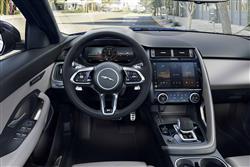Jaguar E-PACE - ABC Leasing
How will you view?
This is a sample, showing 30 seconds of each section.
MIND YOUR E'S and Q'S(some text hidden)
By Jonathan Crouch
Ten Second Review word count: 82
Jaguar's much improved E-PACE brings the company's brand values into the growing market for compact, lifestyle-orientated SUVs. There are smarter looks and improved infotainment, plus as before, sporty cues are borrowed from the Coventry maker's F-TYPE sportscar. Under the skin, the latest Premium Transverse Architecture underpinnings hail from the successful Range Rover Evoque, which means that this little Jag can now offer a more efficient range of electrified engines. All the ingredients seem to be in place then, for a strong package.
Background word count: 213
Did you ever think Jaguar would become a brand with sales based mainly around SUVs? It is today. The company's mid-sized F-PACE model introduced the crossover community to the concept of a Jag, but it's this smaller E-PACE that's now this manufacturer's most accessible model. The name suggests an electric connection - misleadingly as it turns out. Jaguar has another SUV - the battery-powered I-PACE - to provide that. Both are cars the company decided it needed but found it didn't have the capacity to build. Hence the need for an agreement with Magna Steyr in Austria, who've been making G-Class models for Mercedes since 1979 and build all the E-PACE variants destined for our market. The car targets the premium part of the SUV 'C'-segment, the compact part of the crossover market aimed at people who need something Qashqai or Ateca-sized but want a posher badge on the bonnet. The JLR business already has a car competing here - the Range Rover Evoque - and, presumably in order to simplify the design process, has based the E-PACE on most of the same engineering used in that model. The improvements that created the second generation Evoque in 2019 have now been carried over to this E-PACE - which has rejuvenated this car's proposition.
Driving Experience word count: 341
Handling of the original version of this model wasn't quite as sharp as we'd expected, so Jaguar's taken steps to improve things, incorporating under the skin the latest stiffer Premium Transverse Architecture structure that the JLR conglomerate has lately built into the Range Rover Evoque and the Land Rover Discovery Sport. As a result, significant improvements in refinement, ride quality and throttle response are claimed. Only the entry-level E-PACE variant - the 163PS 2.0-litre D165 FWD diesel version - uses a non-electrified engine and can be had with front wheel drive and a manual gearbox. All the other derivatives have AWD, a 9-speed automatic and the brand's latest MHEV mild hybrid technology. You can have that 2.0-litre diesel in D165 AWD Auto form; or, with a power hike to 204PS, in D200 AWD Auto guise. There's also a choice of three versions of the brand's 2.0-litre MHEV four cylinder petrol unit, developing either 200PS (P200), 249PS (P250) and 300PS (P300 Sport). The range also now includes a P300e Plug-in Hybrid derivative, which uses a 309PS three cylinder 1.5-litre petrol unit mated to an 80kW Electric Rear Axle Drive motor powered by a 15kWh lithium-ion battery beneath the boot floor. When this is fully charged, up to 34 miles of WLTP-rated all-electric driving range is possible. Whatever your choice of E-PACE variant, you should find on the road that it has very much a Jaguar feel. It's certainly far more of a driver's car than its Land Rover cousins thanks to things like 'Configurable Dynamics' technology that lets drivers personalise throttle, steering and transmission settings, plus the 'Active Driveline' and torque vectoring set-ups are supposed to combine to make this front-driven model fell more like a more involving rear-driven product. All models get a 'JaguarDrive Control' system that gives owners a choice of four selectable driving modes - 'Normal', 'Dynamic', 'ECO' and 'Rain, Ice & Snow'. The optional 'Active Driveline' AWD system can transfer traction to the rear axle in a fraction of a second should a lack of grip demand it.
Pictures (High res disabled)

.jpg)
.jpg)
.jpg)
.jpg)
.jpg)
.jpg)

Scoring
Category: Compact Car
| Performance | |
| Handling | |
| Comfort | |
| Space | |
| Styling | |
| Build | |
| Value | |
| Equipment | |
| Economy | 80% |
| Depreciation | 80% |
| Insurance | 60% |
| Total | 75% |